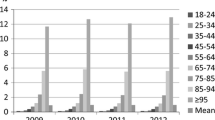Abstract
Background and aims
This study was designed to find predictors for adverse post-operative outcomes in elderly patients aged 80 years and older, who underwent urologic surgery.
Methods
In this prospective observational study, we analysed data, including age, gender, American Society of Anesthesiologists (ASA) class, co-morbidities, number of regular medications, type and extent of surgery, type of anesthesia, duration of surgery and hospitalization, post-operative morbidity and mortality. We studied the correlations between each pre- and intra-operative parameter to the consequence, to find predictors for adverse outcome.
Results
During a 12-month period, 217 patients underwent 294 urologic procedures in our institution. Ninety-eight procedures (33 %) were followed by complications and 11 patients (5 %) died. Patients who had uneventful surgery and hospitalization were significantly younger than those who experienced morbidity or mortality. There was a significantly higher complication rate among patients with a higher ASA class or with ischemic heart disease, following higher graded or longer operations, and after emergency surgery.
Conclusions
Older age is a significant risk factor. Patients with higher ASA class or ischemic heart disease are at higher risk for post-operative complications and thus, require careful follow-up. In this age population, extensive or prolonged surgery should be carefully considered.


Similar content being viewed by others
References
Sprung J, Gajic O, Warner DO (2006) Review article: age related alterations in respiratory function—anesthetic considerations. Can J Anaesth 53:1244–1257
Priebe HJ (2000) The aged cardiovascular risk patient. Br J Anaesth 85:763–778
Schmucker DL (2005) Age-related changes in liver structure and function: implications for disease? Exp Gerontol 40:650–659
Kramer AF, Erickson KI, Colcombe SJ (2006) Exercise, cognition, and the aging brain. J Appl Physiol 101:1237–1242
Maggio M, Cappola AR, Ceda GP et al (2005) The hormonal pathway to frailty in older men. J Endocrinol Invest 28(11 Suppl Proceedings): 15–9
Beck LH (2000) The aging kidney. Defending a delicate balance of fluid and electrolytes. Geriatrics 55:26–28
Rolls BJ, Phillips PA (1990) Aging and disturbances of thirst and fluid balance. Nutr Rev 48:137–144
Rivera R, Antognini JF (2009) Perioperative drug therapy in elderly patients. Anesthesiology 110:1176–1181
Fultz NH, Herzog AR (1996) Epidemiology of urinary symptoms in the geriatric population. Urol Clin North Am 23:1–10
Dhar HL (2001) Gender, aging, health and society. J Assoc Physicians India 49:1012–1020
Halachmi S, Katz Y, Meretyk S, Barak M (2008) Perioperative morbidity and mortality in 80 years and older undergoing elective urology surgery—a prospective study. Aging Male 11:162–166
Blagosklonny MV (2010) Why human lifespan is rapidly increasing: solving “longevity riddle” with “revealed-slow-aging” hypothesis. Aging (Albany NY) 2:177–182
Marx GF, Mateo CV, Orkin LR (1973) Computer analysis of postanesthetic deaths. Anesthesiology 39:54–58
Wolters U, Wolf T, Stützer H, Schröder T (1996) ASA classification and perioperative variables as predictors of postoperative outcome. Br J Anaesth 77:217–222
Etsten B, Proger S (1955) Operative risk in patients with coronary heart disease. JAMA 159:845–848
Eagle KA, Rihal CS, Mickel MC, Holmes DR, Foster ED, Gersh BJ (1997) Cardiac risk of noncardiac surgery: influence of coronary disease and type of surgery in 3368 operations. Circulation 96:1882–1887
Derrington MC, Smith G (1987) A review of studies of anaesthetic risk, morbidity and mortality. Br J Anaesth 59:815–833
ACC/AHA Task Force on Practice Guidelines (2002) ACC/AHA Guidelines update for perioperative cardiovascular evaluation for noncardiac surgery—executive summary. J Am Coll Cardiol 39:542–553
Ali MJ, Davison P, Pickett W, Ali NS (2000) ACC/AHA guidelines as predictors of postoperative cardiac outcomes. Can J Anaesth 47:10–19
Conflict of interest
None.
Author information
Authors and Affiliations
Corresponding author
Rights and permissions
About this article
Cite this article
Barak, M., Halachmi, S. Factors associated with adverse outcome following urologic surgery in patients aged 80 years and older. Aging Clin Exp Res 25, 75–79 (2013). https://doi.org/10.1007/s40520-013-0011-3
Received:
Accepted:
Published:
Issue Date:
DOI: https://doi.org/10.1007/s40520-013-0011-3




